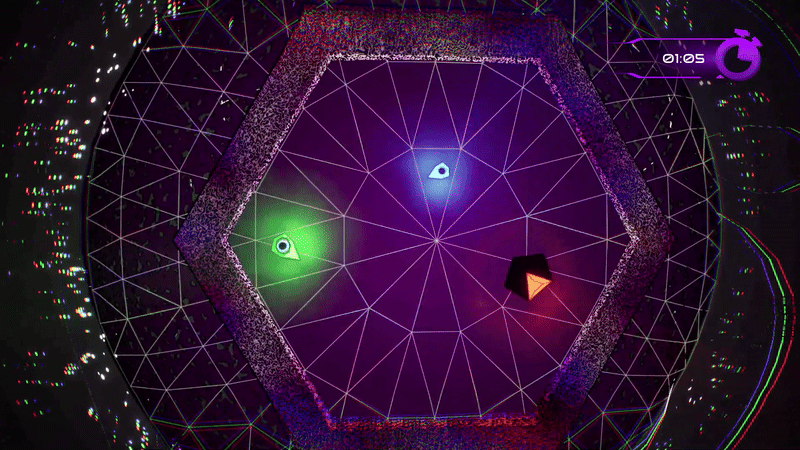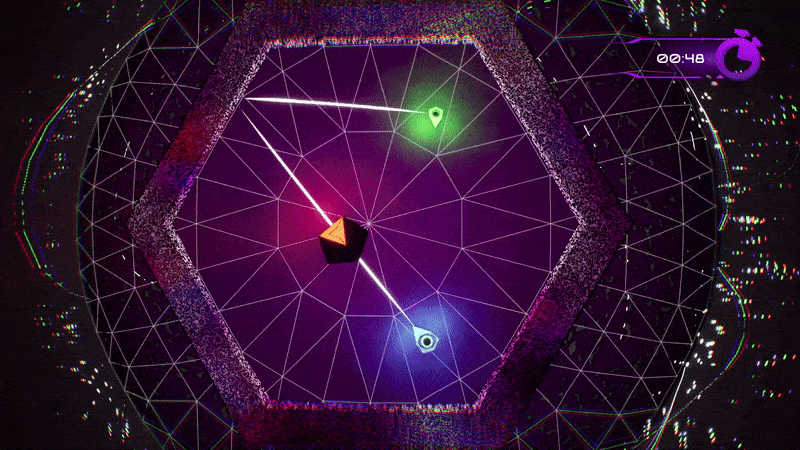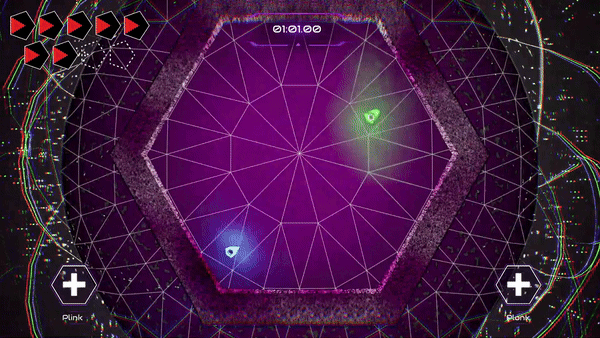A fast-paced cooperative action game for two players that leverages communication and coordination to create an environment where split-second decisions are the only barrier between winning or losing.
6 people
8 Weeks
Unreal
PC Windows
Singleplayer
ROLE AND TASKS
Throughout the development of the game, I have been involved as a Game, Level, and Technical Designer, working on the ideation and implementation of the core gameplay dynamics and aligning the components to the player experience.
Designed the core combat dynamics and player experience
Implemented level progression and flow and iterated based on playtesting data
Designed and scripted the final encounter
Developed and supported the Character systems from prototyping to release
Designed and implemented the Camera system to enhance the player experience
Supported team alignment
Avaliable on Itch.io
DEFINING GAMEPLAY
The key driving force for the development was creating a game where cooperation was foundational to the player experience.
To achieve this, the action has been built on simple and readable mechanics, using clear verbs and interactions that could support moment-to-moment gameplay based on player-driven dynamics.
AIM
SHOOT
CATCH
The most encumbering challenge in the design of the core game loop has been balancing the action between the two players. The objective was to give players equal importance, low downtime, and a constant flow of interesting situations to solve.
The solution has been to consider the game mostly as a spatial challenge, having players constantly question their place on the map. From avoiding enemies to properly bouncing shots, the locations of players become the determining factor for their success. This gave the game solid guidance to steer gameplay decisions and more stable foundations to build a coherent and cohesive player experience.
THE TWO-BODY PROBLEM
DESIGN BREAKDOWN
DESIGN PILLARS
All the mechanics and systems of the game are founded on the cooperation between players. No verb is applicable alone and no goal is achievable independently. Only through shared effort is possible to unlock the experience.
COLLABORATION
It is the key interconnection between the elements of the game. The design of the mechanics and dynamics keeps all the elements in constant motion, creating an ever-evolving experience.
MOVEMENT
It is the main objective of the game and the only possible interaction between the systems of the game. It adds purpose to the elements and gives players a common goal and a drive to the experience.
COMBAT
All the necessary mechanics and systems are introduced and explained during the stage without using any more information other than the gameplay itself. The process of active learning helped solidify the players’ understanding of the game dynamics, giving them the instruments to confidently face the challenge and be fully welcomed by the experience.
SHOW DON’T TELL ONBOARDING
The setup of the rules of the game. It creates lenses teaching verbs and key interactions for the players to use to understand the game’s states and be fully absorbed in the experience.
INTRODUCTION
The fundamentals are put to the test, creating challenging situations that require fast reasoning, complete coordination, and a solid understanding of the rules of the game.
DEVELOPMENT
The systems are reshuffled, presenting a new threat that demands players to adapt their playstyle, analyse how the playspace behaves and plan accordingly.
TWIST
All the pieces are now in play, and it’s time for the players to make their coordination shine and bring it home, concluding the experience with a bombastic finale.
SHOWOFF
The stages are constructed so that the transition between the different moments of the progression works as a gate. It forces players to have acquired all the necessary knowledge, unlocking the experience one learning at a time.
GATED PROGRESSION
Progression is built to allow knowledgable players to move faster through the experience, rewarding the knowledge and coordination acquired in the multiple attempts, allowing them to access the appropriate challenge quickly and keeping the experience engaging.
MASTERY
BOSS: DESIGN AND IMPLEMENTATION
The twist and showoff of the game are built around a climactic boss fight that repurposes the same vocabulary players have encountered so far to deliver a spiced-up player experience that challenges players for three different phases.
The first phase introduces the new form the enemies take, giving time for players to understand how the vocabulary has evolved, how the playspace behaviour has changed, and letting them figure out a way to adapt to the game state.
PHASE I
The fight adds layers, repurposing even more components and creating an even more prominent no man’s land for the players to fight through. The changes are meant as a final test of players’ positioning and coordination.
PHASE II
The ramp-up in speed and the additional spawn of enemies balance out the evolution of the stage, keeping players focused and giving them a final obstacle to overcome before getting the hard-fought end to the experience.
PHASE III
The changes are based on the spatial gameplay dynamics foundational to the game, challenging positioning, avoidance, and coordination in a new, fresh way and adding important stepping stones to support the intended player experience.
CHANGING THE RULES OF PLAY
VERBS: DESIGN AND IMPLEMENTATION
The state of the character determines the functionality of the input, switching between Aiming and Moving. This design supports the readability of the game state and clearly inform action spaces to the players.
CONTEXTUAL INPUTS
The input not only releases the weapon. Players can hold it for a limited time to access slow motion and aiming laser. This design support hectic play giving windows of opportunity for tactics and positioning.
SHOOT
Allows fast movement and invincibility frames, making it a necessary tool to avoid threats and revive players. Dashing gets harder the longer the game goes on, making it a tool players need to master effectively.
DASH
But the character is not the only element that is affected by these verbs. The weapon is the key means of interaction with the game, and the other half of the mechanics.
After a player shoots the weapon, it can only be picked up by the second one. If it bounces two times, it loses its owner and goes dormant. This creates a hectic environment in which positioning is the keystone.
OWNERSHIP
The weapon can bounce on the scenario and on some of the enemies, always being reflected to the second player. This improves the readability of the action adding layers for the players to unfold and master.
BOUNCE
CAMERA: DESIGN AND IMPLEMENTATION
To support the player experience, pushing players to learn and master the mechanics, the camera had to communicate the game state at all times with all the necessary information on display, never subtracting input from the players.
CLARITY
To keep the view hectic and appealing, the camera follows the ever-moving halfway point between the players, with a limited movement buffer, allowing for a snapping response to players’ actions and an extremely reactive feel.
FLUIDITY
The camera was the primary vehicle we had access to to communicate with the players. Implementing zooms while loading a shot, shaking on bounces, or modifying camera vision in any way allowed us to properly convey the impact of players’ actions.
VOCABULARY
As a team with no artists, we had limitations in our processes, but we did not let them stop us. Wearing multiple hats and working on areas outside our comfort zone, we targeted a player experience within our reach, building solid processes to achieve our goals.
To reach the target, consistent playtesting and the health of the build were of primary importance. A strong QA pipeline and proper tracking were the spine of our development processes, confidently ferrying the game from iteration to iteration closer and closer to the intended player experience.
BLOOD, SWEAT, AND TEARS
The development of Plink Plonk has been an exploration voyage at the discovery of what the game wanted to be, harnessing its true nature, and working towards delivering a coherent and cohesive player experience.
Trying to make a two-player cooperative game has been a true challenge. Balancing the action spaces within the moment-to-moment gameplay of a coop experience took blood, sweat, and tears, but it gave me a new perspective on game development. Even though I have always believed in the importance of having a target player experience to drive development, this project made me see how defined it needs to be to make a positive impact on the process and on the team.
The necessity of pivoting competencies, adapting to the constant flow of development, and working outside of the comfort zone has also been a key ingredient in the development of the game. To deliver the intended player experience, a team needs to overcome technical challenges, lack of competencies, or any other possible setbacks, and thanks to the weeks spent on this project and the outstanding team I had alongside me I know finally recognize what professional developers do in these kind of moments: adapt and overcome together.





























